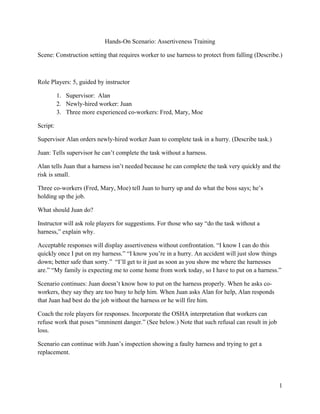
Assert Training Scenario
- 1. Hands-On Scenario: Assertiveness Training Scene: Construction setting that requires worker to use harness to protect from falling (Describe.) Role Players: 5, guided by instructor 1. Supervisor: Alan 2. Newly-hired worker: Juan 3. Three more experienced co-workers: Fred, Mary, Moe Script: Supervisor Alan orders newly-hired worker Juan to complete task in a hurry. (Describe task.) Juan: Tells supervisor he can’t complete the task without a harness. Alan tells Juan that a harness isn’t needed because he can complete the task very quickly and the risk is small. Three co-workers (Fred, Mary, Moe) tell Juan to hurry up and do what the boss says; he’s holding up the job. What should Juan do? Instructor will ask role players for suggestions. For those who say “do the task without a harness,” explain why. Acceptable responses will display assertiveness without confrontation. “I know I can do this quickly once I put on my harness.” “I know you’re in a hurry. An accident will just slow things down; better safe than sorry.” “I’ll get to it just as soon as you show me where the harnesses are.” “My family is expecting me to come home from work today, so I have to put on a harness.” Scenario continues: Juan doesn’t know how to put on the harness properly. When he asks co- workers, they say they are too busy to help him. When Juan asks Alan for help, Alan responds that Juan had best do the job without the harness or he will fire him. Coach the role players for responses. Incorporate the OSHA interpretation that workers can refuse work that poses “imminent danger.” (See below.) Note that such refusal can result in job loss. Scenario can continue with Juan’s inspection showing a faulty harness and trying to get a replacement. 1
- 2. Refusing to Work Because Conditions are Dangerous When you believe working conditions are unsafe or unhealthful, you should call your employer's attention to the problem. If your employer does not correct the hazard or disagrees with you about the extent of the hazard, you also may file a complaint with OSHA. Refusing to do a job because of potentially unsafe workplace conditions is not ordinarily an employee right under the OSH Act. (Your union contract or state law may, however, give you this right, but OSHA cannot enforce it.) Refusing to work may result in disciplinary action by the employer. However, employees do have the right to refuse to do a job if they believe in good faith that they are exposed to an imminent danger. "Good faith" means that even if an imminent danger is not found to exist, the worker had reasonable grounds to believe that it did exist. But, as a general rule, you do not have the right to walk off the job because of unsafe conditions. If you do and your employer fires or disciplines you, OSHA may not be able to protect you. So, stay on the job until the problem can be resolved. Your right to refuse to do a task is protected if all of the following conditions are met: Where possible, you have asked the employer to eliminate the danger, and the employer failed to do so; and You refused to work in "good faith." This means that you must genuinely believe that an imminent danger exists. Your refusal cannot be a disguised attempt to harass your employer or disrupt business; and A reasonable person would agree that there is a real danger of death or serious injury; and There isn't enough time, due to the urgency of the hazard, to get it corrected through regular enforcement channels, such as requesting an OSHA inspection. When all of these conditions are met, you take the following steps: Ask your employer to correct the hazard; Ask your employer for other work; Tell your employer that you won't perform the work unless and until the hazard is corrected; and Remain at the worksite until ordered to leave by your employer. If your employer discriminates against you for refusing to perform the dangerous work, contact OSHA http://www.osha.gov/as/opa/worker/refuse.html 2